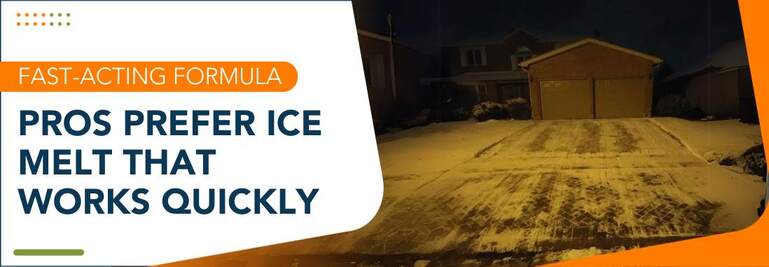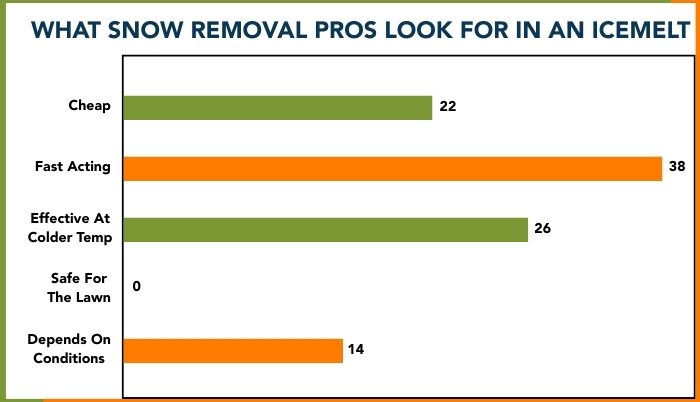Best Ice Melt for Concrete and Hardscaping: Preserve your Investment!
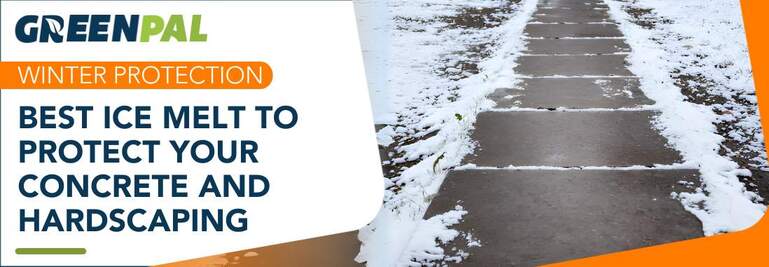
Did you know that ice melts can be harmful to concrete and other hardscaping pathways, such as those made out of flagstone?
It's true; ice melts can corrode away at hardscaping surfaces over time and cause $1,000's in damage.
But if you choose the proper ice melt and use it properly, you can preserve hardscaping for years and years to come.
So how do you use an ice melt on your concrete without damaging it?
That's what we are going to look into today.
Let's dive in!
What is the safest ice melt for use on concrete?
In short, while many ice melts will damage concrete over time, the best ice melt for use on your hard surfaces is magnesium chloride. Magnesium chloride will is also safe to use around metal surfaces.
However, calcium chloride is a very close second-best option, but it should not be used on freshly poured concrete.
Peladow is one of the more popular calcium chloride ice melt brands. While it is more expensive, it goes much further than regular ice melts.
Further, it is generally safe for pets and is one of the best ice melts for your lawn.
Comparison of Ice Melt Types for Concrete
| Ice Melt Type | Effectiveness | Safety for Concrete | Pet Safety | Cost |
|---|---|---|---|---|
| Magnesium Chloride | High | Best | Safe | Higher |
| Calcium Chloride | High | Good | Generally Safe | Higher |
| Rock Salt (Sodium Chloride) | Moderate | Poor | Not Safe | Lower |
Why do ice melts deteriorate concrete?
The process of concrete flaking is called spalling. Palling occurs through the process of the ice melting and water saturating into the concrete. When the mixture freezes inside of the concrete, it will cause the concrete to spall.
Additionally, if your concrete has a coated surface, some winter melts will eat the surface coating away,
Over time this spalling process can ruin your walkways and driveways.
To prevent spalling, you want to select the right ice melt, and then use it correctly.
The reason calcium chloride is a superior ice melt when it comes to your cement and asphalt is that it will not enter the concrete and refreeze. This will prevent the concrete from spalling.
Looking for more info on how to protect your driveway? Protect your driveway by using these 5 ways to keep weeds out!
What quality do snow removal pros look for in an ice melt?
We surveyed a group of lawn care pros to see what quality they look for in an ice melt, and the chart below lays out the results of the survey.
As you can see from the results, the biggest quality snow removal pros look for in an ice melt is the speed with which it acts.
A further 26% were primarily concerned about how an ice melt works at colder temperatures.
And the 3rd quality snow removal pros looked for was the affordability of the melt, with 22% of respondents saying that they were primarily concerned about the cost of the winter melt.
How to Properly Melt Ice from Your Hardscaping
Half of the battle in protecting your hardscapes from ice melt and salt damage is to use your ice melt properly. By using an ice melt properly, you can reduce the amount of ice melt you need and prevent the damages it may cause.
In order to safely melt ice from your sidewalks, and driveway, you should follow these 3 simple tips:
Pre-apply winter melt before it snows
Remove snowfall before spreading a melt on top of it.
Use only what you need
If you live in a state like Vermont, New Hampshire, or Michigan, where you get a lot of snow each year, you will want to keep reading.
Or hire a snow removal service that will treat your ice for you.
1. Pre-apply Ice Melt Before the Storm
Most people don't do this, but it's important to spread ice melt on your concrete surfaces before it snows.
Why?
It's simple, doing so will prevent the snow and/or ice from sticking to the surface of your walkways.
This will make it easier to remove with a shovel before spreading more ice melt. And will GREATLY reduce the amount of ice melt you need to use each time it snows.
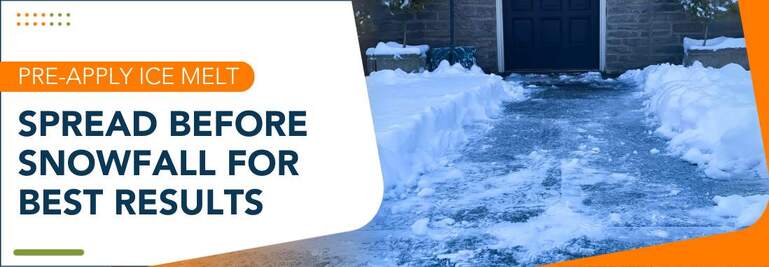
2. Remove Snow Before Spreading an Ice Melt
The most important step to reducing the amount of ice melt you need to use is to remove the snow before it compacts and turns to ice.
This will greatly reduce your dependency on ice melts.
Remove the snow immediately. Once the snow has settled and compacted, it can be much more difficult to remove.
Pro Tip! Never spread an ice melt on top of freshly fallen snow before shoveling it. Otherwise, you are wasting ice melt and raising the risk of damaging your concrete and hardscapes
3. Use Only What You Need
If you follow the tips above, you won't need to use nearly as much ice melt.
Simply apply a light, even layer across your concrete and flagstone walkways.
Spread the ice melt evenly, and you won't need to use as much.
Pro Tip! Use a colored ice melt. This will help you see where you have spread your winter melt already. And prevent you from overspreading it in the same locations.
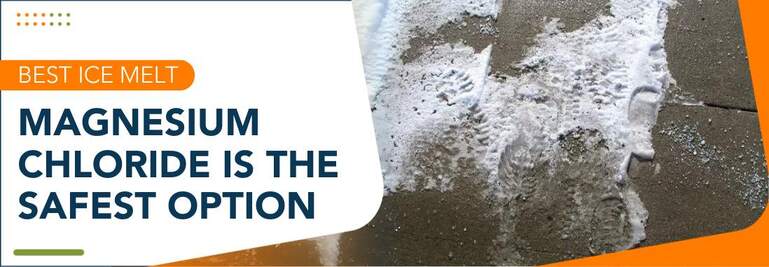
TL;DR: Essential Guide to Using Ice Melts on Concrete Surfaces
| Ice Melt Feature | Details |
|---|---|
| Best Ice Melts | Magnesium Chloride (safest), Calcium Chloride (second best) |
| Usage Tips | 1. Pre-apply before snow 2. Remove snow before applying melt 3. Use only the necessary amount |
| Safety for Concrete | Magnesium Chloride: Best, Calcium Chloride: Good, Rock Salt: Poor |
| Pet Safety | Magnesium Chloride: Safe, Calcium Chloride: Generally Safe, Rock Salt: Not Safe |
| Cost | Magnesium Chloride: Higher, Calcium Chloride: Higher, Rock Salt: Lower |
| Effectiveness | Magnesium Chloride: High, Calcium Chloride: High, Rock Salt: Moderate |
| Pros' Preferences | Speed of action, effectiveness in cold temperatures, affordability |
| Key Consideration | Avoiding concrete damage (spalling) due to refreezing inside concrete |
| Additional Tips | Use colored ice melt to avoid overspreading, hire snow removal services as needed |
In a Nutshell: The Best Ice Melt for Use on Your Concrete
At the end of the day, safely melting ice from your concrete is simple when you use a good ice melt, and more importantly, use it correctly.
Magnesium chloride is likely going to be your best bet; better yet, it is pet safe too!
While magnesium and calcium chloride are more expensive, they go much further than most other ice melts and will help you preserve the investment in your hardscapes.
If you are looking for more info on how to prepare your lawn and home for winter, check out this guide to winterizing your lawn care equipment.





 Share
Share




